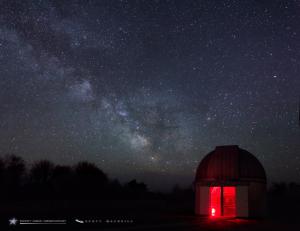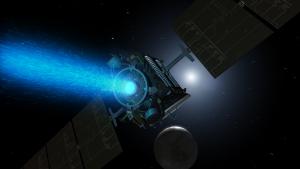
Public Stargazing
- Where:
- Frosty Drew Observatory
- When:
- Friday May 15, 2015 at 8:00 p.m.
- Cost:
- $1 Suggested Donation per Person
Tonight's forecast is calling for partly cloudy conditions with full cloud cover prevailing overnight. This is quite unfortunate as this would have been one of the best weekends of the year for stargazing at Frosty Drew Observatory. The 3% waning crescent Moon rises at 4:39 a.m. leaving a fabulous night of spectacular Milky Way viewing, had clouds not interfered. Overall, we may get a view or two of Venus and Jupiter as afternoon clouds move out before the larger onset of clouds set in, though I wouldn't front for making the long haul tonight.
We plan to open the Observatory and Sky Theatre at 8:00 p.m. In the Observatory we will attempt views of Venus, which is in a fabulous 61% waning gibbous phase. Then, if weather permits, we will try for a peek at Jupiter and all four Galilean Moons. If the weather decides to hook us up, we may get a view of the Great Red Spot on Jupiter as it comes into view around 10:00 p.m. In the Sky Theatre skies are always clear and a slide show of astrophotos shot at Frosty Drew will be on display. We plan to stay on site until the weather kicks us out.
With tonight's rapidly degrading forecast I would be wary about traveling longer distances to visit. Be sure to check in with our Twitter (@FrostyDrewOBSY) or Facebook for updates on conditions at the Observatory. Then step out on a clear night this week and check out Venus in the West, Jupiter overhead, and Saturn in the East as we move into warmer nights and gear up for excellent Milky Way viewing which is happening overnight right now.
-------------------------------------------------------------------------
Weekly Happenings
Scott MacNeill
This past week, the mind-blowing-awesome NASA Dawn mission, which has been orbiting dwarf planet Ceres since March, completed its first mapping orbit. Taking 15 days to complete at an altitude of about 8,388 miles, Dawn has successfully created a low resolution map of the surface of Ceres. If that isn't cool enough, the science just keeps getting better as Dawn is now descending to its second mapping orbit.
Arriving at Ceres in March 2015, Dawn is the first spacecraft to acquire orbit around a dwarf planet, and it is the first spacecraft to orbit two separate solar system objects in the same mission. Descent to the second mapping orbit will take about a month with an arrival date set for June 6th. This new orbital pattern will bring Dawn to an altitude of only 2,700 miles, about three times closer than the first mapping orbit. The science goals of this stage will be to create a comprehensive map of Ceres surface and to start building a geological history of Ceres.
Improved images of Ceres surface are being released on a regular basis and the view is stunning! Just this past week a fabulous image of the mysterious “white spot” on Ceres has been released and speculation continues to mount as to what it is. We now know that it is not only one spot but many individual spots all closely grouped. Additionally, it is also now known that the spot is certainly reflecting massive amounts of sunlight. This significantly increases the likelihood that these spots are regions of ice on Ceres surface. Check out the image for yourself. What do you see? A donkey kicking a beach ball?
With the Dawn mission just getting geared up at Ceres, so many awesome discoveries await. Keep up with the fascinating happenings at the Dawn mission page then head over to NASA JPL PhotoJournal and catch a glimpse at the amazing imagery coming home from the Dawn spacecraft.
Save the Date:
The Meridian Project is returning to Frosty Drew Observatory to rock the skies with their new performance “Sun and Moon” on June 12th and 13th. Be there!
Starting May 30th and continuing every Saturday until August 29th, Frosty Drew Observatory & Sky Theatre will be hosting our Summer Saturdays Stargazing event. If the bustle of the Frosty Drew geekery on Friday nights is hammering your astro experience, then check out our events calendar and learn about kicking back and visiting on Saturdays. Find your inner astro-geek this summer at Frosty Drew Observatory!
-Scott


